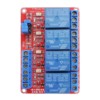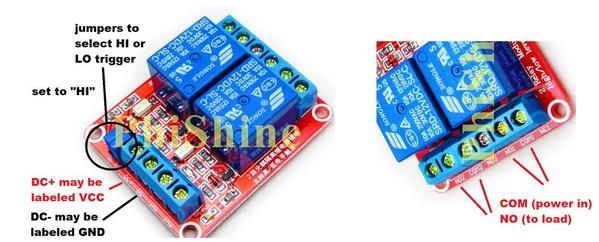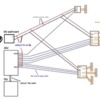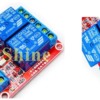Hello, would anybody know of a source for mini toggle switches SPST and push button switches that will handle 10 amp as re-doing my layout and control panel had to be reduced in size. The switches can have soldered legs. Checked ever where I could think of but no results. My power supply will be coming from 180w bricks. Thnks, Mikie
Replies sorted oldest to newest
DA 'BAY IS THE WAY
All Electronics has everything you need.
Digikey and Mouser if you want certifiable quality.
Most mini toggle switches are 5A AC or less. You might be ok with dpdt and parallel both sides of the switch.
Another option is to use relay modules. Control panel would have pushbutton and/or toggles switches that switch 12V DC. Here's an example of a 4 channel relay module. The relays handle 10 Amps. These modules come in 1, 2, 4, 8, 16 channel versions and are about $1 per relay on eBay (free shipping from Asia). You need a source of 12V DC which can be a $2-3 adapter or wall-wart.
The switches are only handling less than 0.1 Amps so virtually any switch will work. Even when adding the $1/relay cost, I think you'd spend less per channel than a 10 Amp switch. Obviously the switches can be physically smaller since they are carrying less current. But the big plus is the vastly wider selection when not constrained by the 10 Amp requirement. Wider selection also includes, for example, illuminated toggle switches; there have been OGR threads describing this method using commonly available and inexpensive 12V DC automotive switches.
Because the control panel switches are carrying low current, you can use much thinner wiring behind the panel. This means easier soldering and less bulky harnesses. The relay modules are typically located close to the point of use which means wiring from control panel to relays can use thinner wire.
In the real world the relay "method" is pretty much how all control panels operate. And taken to its logical conclusion the use digital control panels or virtual touch-screen "switches" means control currents get so tiny that you don't even need wires between the control panel and the relays. Oh wait, that's remote control. ![]()
Just an idea. We now return to your regularly scheduled programming...
Attachments
If you are going to York there is a guy in the orange hall that has plenty of 10 amp switches. If not, than get on the internet.
5 amp rating usually is at 110 volts. That amp capacity increases when the voltage drops to model train application.
stan2004 posted:Another option is to use relay modules. Control panel would have pushbutton and/or toggles switches that switch 12V DC. Here's an example of a 4 channel relay module. The relays handle 10 Amps. These modules come in 1, 2, 4, 8, 16 channel versions and are about $1 per relay on eBay (free shipping from Asia). You need a source of 12V DC which can be a $2-3 adapter or wall-wart.
The switches are only handling less than 0.1 Amps so virtually any switch will work. Even when adding the $1/relay cost, I think you'd spend less per channel than a 10 Amp switch. Obviously the switches can be physically smaller since they are carrying less current. But the big plus is the vastly wider selection when not constrained by the 10 Amp requirement. Wider selection also includes, for example, illuminated toggle switches; there have been OGR threads describing this method using commonly available and inexpensive 12V DC automotive switches.
Because the control panel switches are carrying low current, you can use much thinner wiring behind the panel. This means easier soldering and less bulky harnesses. The relay modules are typically located close to the point of use which means wiring from control panel to relays can use thinner wire.
In the real world the relay "method" is pretty much how all control panels operate. And taken to its logical conclusion the use digital control panels or virtual touch-screen "switches" means control currents get so tiny that you don't even need wires between the control panel and the relays. Oh wait, that's remote control.
Just an idea. We now return to your regularly scheduled programming...
This may be the way to go. Thank you, Mike
Freight Train Jim posted:DA 'BAY IS THE WAY
eBay was my first attempt to search but all were 6 amp or less. Thank you, Mike
Tom Tee posted:5 amp rating usually is at 110 volts. That amp capacity increases when the voltage drops to model train application.
This gives another option. Thanks, Mike
An ac switch in place of a dc switch should be of near twice the amps. Because Ac gives a thermal break between wave peaks, Dc hold a peak. (and spikes and arcs more on each contact seperation, removing more metal than an ac break). Dc switches tend to have more "live" cases, ac switches are more insulated.
Amps are the contact/heat worry. The voltage rating is more about insulating properties here.
There are long term make and break differences in Ac and Dc that "need" different materials at contact points to be a "quality" part, as well as case grounding differences in them too. (e.g. a dc toggle may carry a live case and handle, but live ac on a case or handle might not be a geat idea.)
And you should look real hard a mini isnt .5a or 5ma or 5ah.
The .5 got me before.
stan2004 posted:Another option is to use relay modules. Control panel would have pushbutton and/or toggles switches that switch 12V DC. Here's an example of a 4 channel relay module. The relays handle 10 Amps. These modules come in 1, 2, 4, 8, 16 channel versions and are about $1 per relay on eBay (free shipping from Asia). You need a source of 12V DC which can be a $2-3 adapter or wall-wart.
The switches are only handling less than 0.1 Amps so virtually any switch will work. Even when adding the $1/relay cost, I think you'd spend less per channel than a 10 Amp switch. Obviously the switches can be physically smaller since they are carrying less current. But the big plus is the vastly wider selection when not constrained by the 10 Amp requirement. Wider selection also includes, for example, illuminated toggle switches; there have been OGR threads describing this method using commonly available and inexpensive 12V DC automotive switches.
Because the control panel switches are carrying low current, you can use much thinner wiring behind the panel. This means easier soldering and less bulky harnesses. The relay modules are typically located close to the point of use which means wiring from control panel to relays can use thinner wire.
In the real world the relay "method" is pretty much how all control panels operate. And taken to its logical conclusion the use digital control panels or virtual touch-screen "switches" means control currents get so tiny that you don't even need wires between the control panel and the relays. Oh wait, that's remote control.
Just an idea. We now return to your regularly scheduled programming...
Hello Stan,
Going over what to sent this appears to be the way that I'll be going but went on-line to see how to hook up but they show another piece of equipment that seems to be for video. Would you know where I could find how to kook up using a 12v dc wall out let supply. There may be close to 14-16 mini toggles. Thank you for your assistance. Mike
I found some recycled photos which show some hook-up ideas from previous threads. I realize some of the pics do not apply to your situation but hopefully my comments below will clarify.
Above shows general concept. On eBay, the 12V DC output wall-wart adapters usually state use with CCTV video cameras or LED strip lighting. They have the same coaxial barrel plug (5.5mm x 2.1mm). Many eBay sellers will include for "free" or at least sell the adapter (~50 cents) to convert the barrel to screw-terminals so that you don't have to cut/splice/strip the connector. For 16 switches, I recommend getting a 2A (2 Amp) adapter. This should be about $3 on eBay, free shipping from Asia. Be sure to get a "US" plug assuming of course you are in the US. Most sellers make you choose the kind of wall- outlet plug - US, European, etc.
Above was for a DCS AIU remote control hookup but shows the idea of mix-and-match relay modules. In other words, for your 16 channels, depending on your layout "geometry" you may find it easier to mix-and-match between 1, 2, 4, 8, or 16 channel relay modules. The AIU in the diagram would be replaced by your manual control panel with pushbuttons and toggle switches.
The relay modules are all about $1/relay which is really curious (you'd think you'd save a bunch per relay with larger modules). Perhaps obvious, but you don't need to use all channels of a relay module. As diagram illustrates, on the lower 4-channel module only 3 channels are used. Note how, in addition to 1 control wire per relay, each module needs a continuous source of 12V DC (pair of wires) from the wall-wart.
The AIU in previous diagram would be replaced with your 16 (or whatever) switches. As I understand it, you have a mix of SPST momentary pushbuttons and toggles. As you know SPST switches only have 2 terminals but you may find more options in the toggles for 3-terminal SPDT switches; in which case you'd only use 2 terminals - the center terminal and one of the outer terminals. As mentioned previously, the wiring in the control panel and between panel and relay modules is not carrying hi-current AC so thin-gauge (say, #24 or #26) is suitable and easier to work with. The wiring on the outputs of the relay modules carrying the hi-currents would be thicker-gauge (#14 to #16 or whatever you're using). Note the black 12V DC- connection does not even need to go into the control panel though you may want to run it into the panel for future use (illumination or whatever).
In eBay listings, pretty much all will offer HI and LO triggering meaning you can choose to activate a relay channel by applying DC+ (12V) or DC- (GND) to the "IN" control input. There are tiny jumpers that you position one way or the other to select between HI and LO. Depending on vendor, the DC+ input may be labeled VCC, and DC- input may be labeled GND. Note that this module has screw-terminals for the DC+, DC-, and IN connections; there are some modules with pins instead of screw-terminals. I think the screw-terminal inputs might be easier to work with but to each his own. On the hi-current output side all the modules use screw-terminals. In your case you'd be using COM and NO for each channel for SPST action.
So when all's said and done, the 2-terminal SPST switch is "relayed" to the COM and NO terminals of the relay module.
If you still want to pursue this approach but aren't quite sure if your selections are suitable, I or someone here will review your shopping list. I buy a lot of these types of items from Asia sellers on eBay but these items are also available thru Amazon and other US sources though they tend to cost a bit more.
Attachments
stan2004 posted:I found some recycled photos which show some hook-up ideas from previous threads. I realize some of the pics do not apply to your situation but hopefully my comments below will clarify.
Above shows general concept. On eBay, the 12V DC output wall-wart adapters usually state use with CCTV video cameras or LED strip lighting. They have the same coaxial barrel plug (5.5mm x 2.1mm). Many eBay sellers will include for "free" or at least sell the adapter (~50 cents) to convert the barrel to screw-terminals so that you don't have to cut/splice/strip the connector. For 16 switches, I recommend getting a 2A (2 Amp) adapter. This should be about $3 on eBay, free shipping from Asia. Be sure to get a "US" plug assuming of course you are in the US. Most sellers make you choose the kind of wall- outlet plug - US, European, etc.
Above was for a DCS AIU remote control hookup but shows the idea of mix-and-match relay modules. In other words, for your 16 channels, depending on your layout "geometry" you may find it easier to mix-and-match between 1, 2, 4, 8, or 16 channel relay modules. The AIU in the diagram would be replaced by your manual control panel with pushbuttons and toggle switches.
The relay modules are all about $1/relay which is really curious (you'd think you'd save a bunch per relay with larger modules). Perhaps obvious, but you don't need to use all channels of a relay module. As diagram illustrates, on the lower 4-channel module only 3 channels are used. Note how, in addition to 1 control wire per relay, each module needs a continuous source of 12V DC (pair of wires) from the wall-wart.
The AIU in previous diagram would be replaced with your 16 (or whatever) switches. As I understand it, you have a mix of SPST momentary pushbuttons and toggles. As you know SPST switches only have 2 terminals but you may find more options in the toggles for 3-terminal SPDT switches; in which case you'd only use 2 terminals - the center terminal and one of the outer terminals. As mentioned previously, the wiring in the control panel and between panel and relay modules is not carrying hi-current AC so thin-gauge (say, #24 or #26) is suitable and easier to work with. The wiring on the outputs of the relay modules carrying the hi-currents would be thicker-gauge (#14 to #16 or whatever you're using). Note the black 12V DC- connection does not even need to go into the control panel though you may want to run it into the panel for future use (illumination or whatever).
In eBay listings, pretty much all will offer HI and LO triggering meaning you can choose to activate a relay channel by applying DC+ (12V) or DC- (GND) to the "IN" control input. There are tiny jumpers that you position one way or the other to select between HI and LO. Depending on vendor, the DC+ input may be labeled VCC, and DC- input may be labeled GND. Note that this module has screw-terminals for the DC+, DC-, and IN connections; there are some modules with pins instead of screw-terminals. I think the screw-terminal inputs might be easier to work with but to each his own. On the hi-current output side all the modules use screw-terminals. In your case you'd be using COM and NO for each channel for SPST action.
So when all's said and done, the 2-terminal SPST switch is "relayed" to the COM and NO terminals of the relay module.
If you still want to pursue this approach but aren't quite sure if your selections are suitable, I or someone here will review your shopping list. I buy a lot of these types of items from Asia sellers on eBay but these items are also available thru Amazon and other US sources though they tend to cost a bit more.
Hello Stan, Thank you so much for your input. I'll be running Lionel Legacy and with your help will be able to wire the track and sidings. Thank you for your time and pictures. Take care, Mike












